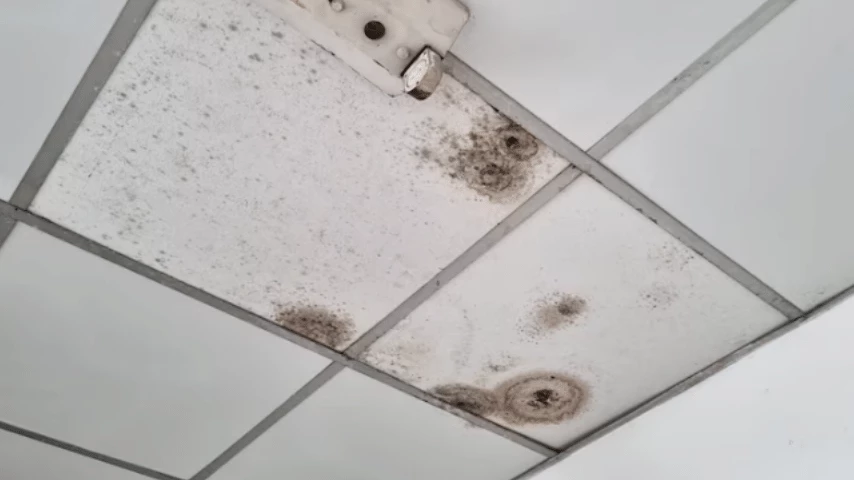
Discovering a water spot on your ceiling can be both alarming and frustrating. It not only mars the appearance of your home but also signals potential damage that could escalate if not addressed promptly. Understanding the causes of a water spot on the ceiling and knowing what steps to take can help you manage the situation effectively and prevent further damage.
What Causes a Water Spot on the Ceiling?
A water spot on your ceiling is a telltale sign of underlying water accumulation issues that should not be ignored. Identifying the source of the problem is crucial for timely and effective resolution. Here are some expanded details on the most common causes of water spots on ceilings:
Roof Leaks
Often the primary suspect behind a water spot on the ceiling, roof leaks demand immediate attention. Damage can occur from several sources:
- Shingle Damage: Storms, aging, or physical impact can lead to broken, cracked, or missing shingles, compromising the roof’s integrity.
- Underlayment Failure: The protective layer under your shingles may fail due to age or poor installation, allowing water to seep.
- Flashing Issues: Over time, flashing around vents, chimneys, and roof junctions can become dislodged or corroded. This often results in water finding its way into your home and causing stains on your ceiling.
Condensation Buildup
This issue is particularly prevalent in high-moisture areas such as kitchens and bathrooms, where inadequate ventilation can lead to excessive moisture. Over time, this moisture can:
- Accumulate: Persistent condensation can lead to water saturation in ceiling materials.
- Penetrate: Water can seep through ceiling materials as it accumulates, resulting in visible water spots.
Plumbing Issues
Water spots directly beneath bathroom floors for kitchens may point to plumbing leaks. These can arise from:
- Aged Pipes: Older pipes can develop leaks over time.
- Faulty Connections: Improperly fitted or worn-out connections can drip, slowly creating water spots.
- Overflowing Gutters: Proper gutter maintenance is crucial. Clogged or misaligned gutters can lead to:
- Water Pooling: Blocked gutters prevent proper water flow, causing water to pool and seep under roof materials.
- Subsequent Leaks: This pooling water can eventually find its way under shingles and into the attic or ceiling cavity.
HVAC Problems
HVAC systems, particularly air conditioning units, can contribute to ceiling water spots due to:
- Condensation Line Issues: Blocked or leaking condensation lines can drip water, leading to stains.
- Insulation Problems: Inadequately insulated ducts can cause condensation, especially when cold air passes through them in a hot attic.
Understanding these potential causes can help you quickly identify and address the source of a water spot, preventing further damage and maintaining the structural integrity and aesthetics of your home.
Identifying the Source of the Leak
Determining the exact source of a water leak is essential for effective resolution and to prevent further damage. It is vital to conduct a thorough investigation by inspecting several critical areas of your home. Here are detailed steps to help identify where the leak might be coming from:
Check the Roof
- Visual Inspection: Start by visually inspecting the roof for any signs of damage. This includes missing, cracked, or curled shingles, which can be particularly vulnerable after extreme weather conditions like heavy storms or high winds.
- Check for Age: Roofs deteriorate with age; an older roof may have compromised materials that allow water to seep through.
- Inspect Flashing: Ensure that the flashing around vents, chimneys, and along the roof’s edges is intact and not corroded, as these are common points for leaks to develop.
Inspect Plumbing
- Above the Ceiling: Focus on the plumbing lines located directly above the area where the water spot has appeared. This could be in the attic or the floor above.
- Look for Leaks and Condensation: Check for any signs of moisture, such as wet pipes, dripping water, or corroded joints. Even small, slow leaks can lead to significant water damage over time.
- Temperature Fluctuations: When exposed to temperature differences, pipes can sweat, which can also contribute to water accumulation.
Examine HVAC Systems
- Insulation Check: Inspect the insulation around the HVAC ducts. Poor insulation can lead to condensation, especially when cool air passes through warm attic spaces.
- Condensate Lines: Ensure the HVAC’s condensate lines are not blocked, disconnected, or damaged. These lines can accumulate a lot of water, especially in humid conditions, and any failure can lead to leaks.
- Regular Maintenance: Regular checks and maintenance of the HVAC system can prevent many issues related to condensation and leakage.
By methodically checking these areas, you can pinpoint the source of the water leak. This helps in quick fixes and prevents the recurrence of similar issues, safeguarding your home against potential water damage.
What to Do When You Find a Water Spot on the Ceiling
Once you notice a water spot on your ceiling, taking immediate action is key to preventing further damage. Here are the steps you can follow:
- Contain the Leak: If the leak is active and water is still dripping, place a bucket or a pan under the leak to catch the water. This will prevent further damage to your flooring and furnishings.
- Dry the Area: Use fans or a dehumidifier to thoroughly dry out the affected area. This helps prevent mold growth, which can be a health hazard and further damage the structure.
- Document the Damage: Take pictures and make notes detailing the extent of the water damage. This can be crucial for insurance claims or future repairs.
- Repair the Source of the Leak: Whether it’s a roofing issue, a plumbing problem, or an HVAC fault, it’s essential to repair the source of the leak to prevent future occurrences. Depending on the issue’s complexity, you may need to consult a professional.
- Clean the Stain: You can address the ceiling stain once the leak is fixed and the area is dry. Painting over the spot may seem like a quick fix, but applying a stain-blocking primer is important to prevent the stain from bleeding through the new paint.
- Consult a Professional: If the cause of the water spot on the ceiling is not apparent or the repair is beyond your DIY skills, it’s advisable to hire a professional. Depending on the identified source of the leak, this could be a roofer, plumber, or general contractor.
Prevention Tips
Preventing future water spots on your ceiling can save you time, money, and stress. Here are some preventative measures:
- Regular Maintenance: Inspect and maintain your roof, plumbing, HVAC systems, and gutters. This includes cleaning gutters, servicing your HVAC units, and ensuring your plumbing is leak-free.
- Improve Ventilation: Enhance ventilation in moisture-prone areas like bathrooms and kitchens to prevent condensation buildup.
- Inspect Ceilings Regularly: Check your ceilings for signs of water damage. Early detection can lead to quicker fixes and less extensive damage.
Finding a water spot on your ceiling can be distressing, but you can effectively handle the situation with the right knowledge and approach. Remember, addressing the issue promptly not only preserves the integrity of your home but also prevents the occurrence of more severe problems in the future.
Act Now to Protect Your Home from Water Damage!
At Eason Roofing, we understand how alarming a water spot on your ceiling can be. It’s more than just an eyesore—it’s a sign that something is wrong and needs immediate attention. Don’t let a minor issue turn into a costly repair. Our team of experienced professionals is here to help you identify and fix the source of the problem quickly and effectively.
Contact us today for a comprehensive roof inspection and repair service. Our roofing experts will ensure that your roof is in top condition, protecting your home from further damage. We offer prompt, reliable, and affordable solutions tailored to your needs.
Call Eason Roofing now or visit our website to schedule your free consultation. Don’t wait until it’s too late—take action to safeguard your home and peace of mind today!




